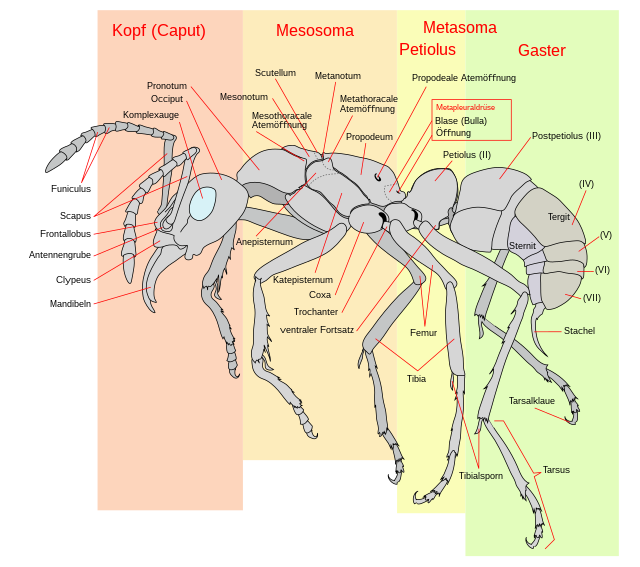
By Scheme_ant_worker_anatomy-en.svg: Mariana Ruiz (User:LadyofHats)derivative work: Matt (Scheme_ant_worker_anatomy-en.svg) [Public domain], via Wikimedia Commons
This morning i woke up with ants crawling on the three walls around me. No, my room does not only have three walls, but i didnt see any ants over there on the fourth. Ants were just mentioned in the Daily Bread too. Just killed another one! Ants aren't like roaches, you'll brag about how many you have in your house, nobody says "Yo check out these pics of the roaches underneath my couch" Everytime i tell that joke i always have to clarify that i'm just jokin (#MitchHedberg reference) i do not have roaches underneath my couch. Not that there's anything wrong with that (#Seinfeld) if you do ,but I dont. ANYWAY FEELIN RATHER LOQUACIOUS EVER SINCE I KINDA LEARNED TO TYPE. with a Tyler the Creator mixed with Sherman Carpenter love for capital letters.
I began to think about the psychic trails they leave for each other to travel on and i saw their similarity/metaphor of it to blogging. People blog trails of where they've been so that others can find a way to the same places they were feeding. The Interweb is so big. We're ants on the Interweb. It's huge. Porn sites are the traps. Don't get wrapped in a cocoon.
So it turns out that they're not psychic trails, but pheromones instead. By that time I had already scanned that new pic you see up top, so we're gonna stay with referring to them as psychic trails. Not just because i'm lazy, but because it sounds cooler.
Peace; LIQUID BONEZ
"Communication
Ants communicate with each other using pheromones.[58] These chemical signals are more developed in ants than in other hymenopteran groups. Like other insects, ants perceive smells with their long, thin and mobile antennae. The paired antennae provide information about the direction and intensity of scents. Since most ants live on the ground, they use the soil surface to leave pheromone trails that can be followed by other ants. In species that forage in groups, a forager that finds food marks a trail on the way back to the colony; this trail is followed by other ants, these ants then reinforce the trail when they head back with food to the colony. When the food source is exhausted, no new trails are marked by returning ants and the scent slowly dissipates. This behaviour helps ants deal with changes in their environment. For instance, when an established path to a food source is blocked by an obstacle, the foragers leave the path to explore new routes. If an ant is successful, it leaves a new trail marking the shortest route on its return. Successful trails are followed by more ants, reinforcing better routes and gradually finding the best path.[59]
Ants use pheromones for more than just making trails. A crushed ant emits an alarm pheromone that sends nearby ants into an attack frenzy and attracts more ants from further away. Several ant species even use "propaganda pheromones" to confuse enemy ants and make them fight among themselves.[60] Pheromones are produced by a wide range of structures including Dufour's glands, poison glands and glands on the hindgut, pygidium, rectum, sternum and hind tibia.[56] Pheromones are also exchanged mixed with food and passed by trophallaxis, transferring information within the colony.[61] This allows other ants to detect what task group (e.g., foraging or nest maintenance) other colony members belong to.[62] In ant species with queen castes, workers begin to raise new queens in the colony when the dominant queen stops producing a specific pheromone.[63]
Some ants produce sounds by stridulation, using the gaster segments and their mandibles. Sounds may be used to communicate with colony members or with other species.[64][65]" Ant Wiki
Friday, May 13, 2011
at 1:46 PM